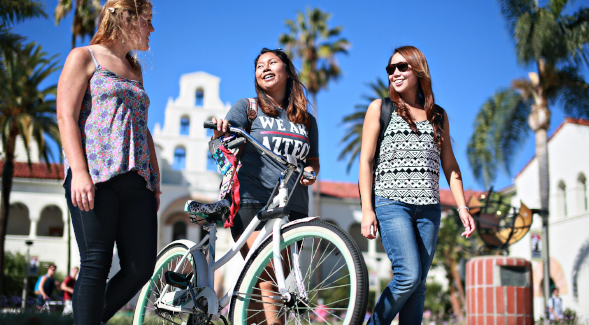SDSU Team Awarded $10 Million Grant Over 5 years to Research Safer Streets for Pedestrians, Cyclists
Bruce Appleyard, is now associate director of the Center for Pedestrian and Bicyclist Safety, will lead research aimed at making streets safer, more liveable, and more equitable.

SDSU teamed with the University of New Mexico, the University of California, Berkeley, the University of Wisconsin at Milwaukee, and the University of Tennessee to create the first-ever USDOT-funded University Transportation Center (UTC) dedicated solely to pedestrian and bicyclist safety.
They will research equity in bicyclist and pedestrian safety and use, as well as street livability and street reimagination and re-design.
The Center for Pedestrian and Bicyclist Safety (CPBS) University Transportation Center (UTC) is a place for faculty and students in SDSU’s School of Public Affairs (SPA), The College of Professional Studies and Fine Arts (PSFA), and SDSU, working with CPBS consortium partners, to conduct research. This is the first UTC to have a home in SPA and PSFA.
“This research will connect our understanding of where and why collisions occur along with real-world problem-solving ways we can better design streets, facilities, vehicles, and operation,” said Bruce Appleyard, the SDSU associate director of the Center for Pedestrian and Bicyclist Safety.
The center will also enable students to develop their skills and get involved in innovative research and problem-solving. It will also provide students with the opportunity to go to conferences and travel for research.
Appleyard, author of Livable Streets 2.0, is director of Active Transportation Research and an associate professor in SPA. For years, he has led the charge for SPA and PSFA to get this UTC funding and focus it on pedestrian and bicyclist safety. And creating CPBS is particularly meaningful to him, as he was nearly killed by a car when he was four, and his father was killed by a speeding drunk driver when he was 17, as told in this article, Livable Streets Revisited.
“A mission of the UTC is to support students and student researchers, and to get students, especially under-represented students, involved at the university and pre-college level,” Appleyard said. “It’s a very applied, on-the-ground, in-the-streets research program with a focus on student academic success.”
Appleyard worked for about 10 years to bring this UTC to SDSU and in 2016, he helped lead the effort to apply to the very same competition in hopes of winning. The team was unsuccessful then but this time around, the team welcomed faculty from the other universities.
This year, the group received the $10 million grant for the next 5 years based on their research ideas, their past research, proposals to study street safety and livability, and their reimagining of how to design streets for our most vulnerable users.
This award marks SDSU as a major player in one of the highest profile Federal Transportation Research Programs in the U.S. This UTC will work toward putting the university on the map for innovative research, not only in transportation, but in how to make our streets safer, more equitable, and more livable for our most vulnerable.
“It gives us the funding and the support to do the interesting and much-needed research for our most abundant and accessible public spaces and for the most vulnerable users,” Appleyard said. “We’re also able to support our students in their research and education, and getting to know more about this side of transportation and the redesign of our streets.”
The team will also look at policies and projects within the government. Appleyard is currently working with several State of California agencies to look at how they manage their active transportation, transit, and climate action investments and will use this opportunity to help further inform his research.
“I am most excited about collaborating with my colleagues and students across SDSU and CPBS consortium to creatively and rigorously tackle the greatest challenges in the way of making our streets safe, livable and enjoyable for our most vulnerable-our pedestrians and bicyclists,” Appleyard said.



